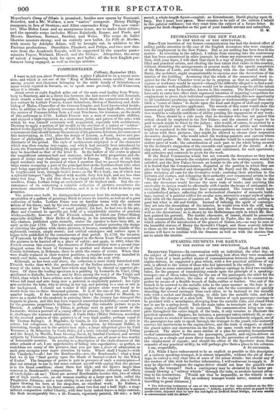DECORATIONS OF THE NEW PALACE.
TO THE EDITOR OF THE SPECTATOR.
Sin—Your insertion of my former communication has had the desired effect of calling public attention to the case of the English decorators who were competi- tors for employment in the New Palace. But as yet nothing has been done in the matter. In reverting to the subject, I refrain from entering into the controversy that has been commenced in other journals, by whom my statements were quoted. Now, with your leave, I will show that there is a way of doing justice to the qua- lified and practical artists, and eliciting the best talent that exists in this country, without disturbing the arrangements at present made for the speedy completion of the House of Lords, and without interfering with the due control that Mr. Barry, the architect, ought unquestionably to exercise over the decorations of the interior of the building. Assuming that the whole of the ornamental work re- (eared for the Peers' Chamber were so far in progress as that no additional de- signers or workmen would be needed—though the difficulty alleged is to find a suf- ficient number well-qualified—there would yet be abundant scope for all the talent that is now, or may be hereafter, known in this country. The Royal Commission have only to carry into effect their expressed intention of requiring competitors for employment to prove their individual capabilities—extending this new opportunity to all candidates producing specimens of design or workmanship—and thus esta- blish a "court of claims" to decide upon the kind and degree of skill and capacity possessed by the respective applicants. The records of this court would show the amount and quality of available talent in the country ; and a copy of its registra- tion would be a valuable certificate of ability pending the engagement of any work- man. There should be a rule made that no decorator who has not passed this ordeal should be employed in the New Palace; and the amount of wages to be paid to each might be fixed by the judges; who would, of course, be assisted by a jury of practical men of business. The distribution of artists and workmen might be regulated in this way. As the fresco-painters are each to have a room to adorn with their pictures, they might be allowed to choose their respective decorative designers; who would select the working-painters and carvers whom they would prefer. By this means, each chamber would be a complete and con- sistent piece of work; the subordination of each part to the whole being secured by the architect's suggestion of the ensemble and approval of the details. A de- sign must, of course, be previously made, and sanctioned, for each apartment; and estimates and contracts be given for the work.
If the Royal Commission would but act towards the decorators as they have done and are doing towards the sculptors and painters, the working-men would be satisfied, and the New Palace become an honour to the arts of the country. But it is feared that the Commissioners, disgusted at the position in which they are placed by being thwarted and disregarded by Mr. Barry and Mr. Pugin, contem- plate resigning all care for the decorative work ; confining their attention to the pictures and statues, and delegating their authority over ornamental artists to the "Board of Works" or the "Office of Woods and Forests." Should this be the case, the decorators would become the mere tools of trade; and anything like originality in design would be effectually stifled under the heaps of antiquated de- vices that Mr. Pugin's researches have accumulated. The country would have a cathedralized palace, reflecting the ecclesiastical character of monastic build- ings, instead of a palatial edifice for secular uses, adorned in a regal style of splen- dour with all the resources of modern art. In Mr. Pugin's estimation, nothing is good but what is old and Gothic. Instead of infusing the spirit of contempo- rary art into the decorations of the interior, he would even wish the stiff, hard, dry manner of the early pictures introduced into the frescoes and sculpture as well as the decorations; as is shown by the Holbeinesque style in which Mr. Her- bert painted his portrait. The Gothic character, of course, should be preserved in the ornamental details; but the style should be Tudor, like the architecture; which admits of the introduction of the graces of Italian art,—as may be seen in the beautiful statues of Henry the Seventh's Chapel, and those scarcely inferior to them on the new building. This is of more importance inasmuch as the deco- rations will have to combine with the frescoes as well as with the statues that are to adorn the interior. —


























 Previous page
Previous page